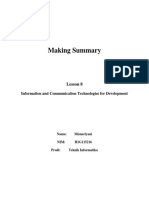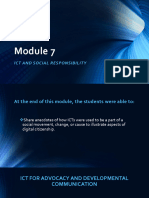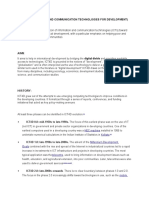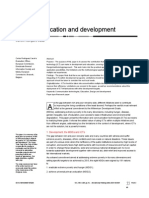0 ratings0% found this document useful (0 votes)
50 viewsUnit: 4 Topic: Community Participation and Sustainable Development
Community participation in development can take different forms and ranges from passive to active involvement. Functional participation involves people taking part in government-led development programs, while popular participation gives people more decision-making power and involvement in implementation. Sustainable development relies on using local resources long-term in an environmentally-friendly way that allows for recycling of resources. The evolution of communication technologies for development (CTDC) has progressed from early uses of IT in organizations to leveraging the internet and mobile phones to share development information and empower the poor as innovators. Current work focuses on extracting knowledge from large data sources to advance knowledge societies and aid development through artificial intelligence.
Uploaded by
Danish MalikCopyright
© © All Rights Reserved
We take content rights seriously. If you suspect this is your content, claim it here.
Available Formats
Download as DOCX, PDF, TXT or read online on Scribd
0 ratings0% found this document useful (0 votes)
50 viewsUnit: 4 Topic: Community Participation and Sustainable Development
Community participation in development can take different forms and ranges from passive to active involvement. Functional participation involves people taking part in government-led development programs, while popular participation gives people more decision-making power and involvement in implementation. Sustainable development relies on using local resources long-term in an environmentally-friendly way that allows for recycling of resources. The evolution of communication technologies for development (CTDC) has progressed from early uses of IT in organizations to leveraging the internet and mobile phones to share development information and empower the poor as innovators. Current work focuses on extracting knowledge from large data sources to advance knowledge societies and aid development through artificial intelligence.
Uploaded by
Danish MalikCopyright
© © All Rights Reserved
We take content rights seriously. If you suspect this is your content, claim it here.
Available Formats
Download as DOCX, PDF, TXT or read online on Scribd
You are on page 1/ 3
Unit: 4 Topic
Community Participation and Sustainable Development
Participation takes different forms in different societies- people may participate by
expressing their development needs by demanding solutions or by expressing
discontentment.
In some societies participation is passive in others it is active.
Participation could be functional or popular participation. Functional Participation is
where people participate in development programmes but as directed by the
government. Govt. mobilizes the people to attain the goals it sets for societies
development, economic or social. Thus people become participants in development
process, although the choice of what they do and how they do is not always theirs.
On the other hand, popular participation is involving large masses of people in decision
making and actual implementation of the programmes.
Sustainable Development Model
Local resources should be used for development
The resources should be sustainable for development for a long term
The resources must be recycled and environment friendly
Developmental Agencies of Government
Reporting on Development Projects
Communication Technologies and Development Communication
Information and communication technologies for development refers to the
application of information and communication technologies (ICT) toward
social, economic, and political development, with a particular emphasis on
helping poor and marginalized people and communities. It aims to help in
international development by bridging the digital divide and providing
equitable access to technologies. It is grounded in the notions of
"development", "growth", "progress" and "globalization" and is often
interpreted as the use of technology to deliver a greater good. Another
similar term used in the literature is "digital development". It draws on
theories and frameworks from many disciplines, including sociology,
economics, development studies, library, information science, and
communication studies.
CTDC grew out of the attempts to use emerging computing technologies to
improve conditions in the developing countries. It formalized through a
series of reports, conferences, and funding initiatives that acted as key
policy-making avenues: the 1998 World Development Report from the
World Bank, highlighting the role of knowledge and ICTs in development; a
report from the G8 Digital Opportunities Task Force, concluding that ICTs
play a key role in modern human development, the World Summit on the
Information Society held in Geneva in 2003 and Tunis in 2005.
At least three phases can be identified in CTDC evolution:
CTDC 0.0: mid-1950s to late-1990s. The focus of this earliest phase was on
the use of IT (not ICT) in government and private sector organizations in
developing countries. One of the earliest computers used in a developing
country was a HEC machine installed in 1956 to undertake numerical
calculations in the Indian Institute of Statistics in Kolkata.
CTDC 1.0: late-1990s to late-2000s. The advent of the Millennium
Development Goals combined with the rise and spread of the Internet in
industrialized countries led to a rapid increase in investments in ICT
infrastructure and projects in developing countries. The most typical
application was the telecentre, used to bring information on development
issues such as health, education, and agricultural extension, into poor
communities.
CTDC 2.0: late-2000s to mid-2010s. There is no clear boundary between
phases 1.0 and 2.0. The focus in phase 2.0 increasingly shifts toward
technologies in use, such as the mobile phone and SMS technologies.
There is less concern with e-readiness and more interest in the impact of
ICTs on development. Additionally, there is more focus on the poor as
producers and innovators with ICTs (as opposed to being consumers of
ICT-based information). CTDC 2.0 is about reframing the poor. Where
CTDC 1.0 marginalized them, allowing a supply-driven focus, CTDC 2.0
centralizes them, creating a demand-driven focus. Where CTDC 1.0 –
fortified by the "bottom of the pyramid" concept – characterized them
largely as passive consumers, CTDC 2.0 sees the poor as active producers
and active innovators.
Current Evolution: The most prominent recent change has been a shift in
focus from the proliferation of communication (1970s & 1990s) and
information (1990s & 2000s), to the extraction of knowledge from the
resulting data. A shift from “‘Information Societies’ to ‘Knowledge
Societies’”. Work focused on the use of big data for development quickly
led to AI4D (Artificial Intelligence for Development).
You might also like
- Instruction Manual: Installation - Operation - MaintenanceNo ratings yetInstruction Manual: Installation - Operation - Maintenance20 pages
- MODULE 1: What Is ICT4D?: Out. and The Most Insightful Answer From The People Who Devote Their Lives To TheseNo ratings yetMODULE 1: What Is ICT4D?: Out. and The Most Insightful Answer From The People Who Devote Their Lives To These7 pages
- The Link Between ICT and Economic Growth in The Discourse of DevelopmentNo ratings yetThe Link Between ICT and Economic Growth in The Discourse of Development8 pages
- Content Development by Communities - Case Studies in The PhilippinesNo ratings yetContent Development by Communities - Case Studies in The Philippines15 pages
- Information Communication Technology For Community Development: A Case Study of Hatcliffe High Density Residential Area in Harare, ZimbabweNo ratings yetInformation Communication Technology For Community Development: A Case Study of Hatcliffe High Density Residential Area in Harare, Zimbabwe11 pages
- Document WSIS/PC-2/CONTR/17-E 6 December 2002 English OnlyNo ratings yetDocument WSIS/PC-2/CONTR/17-E 6 December 2002 English Only4 pages
- Media and development 1st Edition Richard Vokes - The latest ebook edition with all chapters is now available100% (2)Media and development 1st Edition Richard Vokes - The latest ebook edition with all chapters is now available61 pages
- Social, Economic, and Political Development, With A Particular Emphasis On Helping Poor and Marginalized People and CommunitiesNo ratings yetSocial, Economic, and Political Development, With A Particular Emphasis On Helping Poor and Marginalized People and Communities2 pages
- Social Media For Development Outlining Debates Theory and PraxisNo ratings yetSocial Media For Development Outlining Debates Theory and Praxis8 pages
- Content Creation For ICT Development Projects: Integrating Normative Approaches and Community DemandNo ratings yetContent Creation For ICT Development Projects: Integrating Normative Approaches and Community Demand11 pages
- ICTD 2.0, Peer Production and Open DevelopmentNo ratings yetICTD 2.0, Peer Production and Open Development4 pages
- ICT: An Effective Tool in Human Development: Kuyoro Shade O. Awodele O. Okolie Samuel ONo ratings yetICT: An Effective Tool in Human Development: Kuyoro Shade O. Awodele O. Okolie Samuel O6 pages
- [Ebooks PDF] download Media and development 1st Edition Richard Vokes full chapters100% (3)[Ebooks PDF] download Media and development 1st Edition Richard Vokes full chapters65 pages
- Outline Lesson 8 (Exercise) Information and Communication Technologies For DevelopmentNo ratings yetOutline Lesson 8 (Exercise) Information and Communication Technologies For Development4 pages
- Boundary-objects-to-guide-sustainable-technologysupported-participatory-development-for-poverty-alleviation-in-the-context-of-digital-dividesElectronic-Journal-of-Information-Systems-in-Developing-Countries.pdfNo ratings yetBoundary-objects-to-guide-sustainable-technologysupported-participatory-development-for-poverty-alleviation-in-the-context-of-digital-dividesElectronic-Journal-of-Information-Systems-in-Developing-Countries.pdf25 pages
- L14 Information Technologies in The Professional SphereNo ratings yetL14 Information Technologies in The Professional Sphere19 pages
- The Impact of Information and Communication Technologies On The Human Development in The Gulf Cooperation Council Countries: An Empirical StudyNo ratings yetThe Impact of Information and Communication Technologies On The Human Development in The Gulf Cooperation Council Countries: An Empirical Study35 pages
- Participatory communication for development practice a case of community mediaNo ratings yetParticipatory communication for development practice a case of community media14 pages
- Information and Communication Information and Communication Technologies (Icts) Technologies (Icts)No ratings yetInformation and Communication Information and Communication Technologies (Icts) Technologies (Icts)5 pages
- Using A Sustainable Livelihoods Approach To Assessing The Impact of Icts in DevelopmentNo ratings yetUsing A Sustainable Livelihoods Approach To Assessing The Impact of Icts in Development12 pages
- Ict E: A W A R Q ?: Rgomez@uw - Edu Pathers@cput - Ac.zaNo ratings yetIct E: A W A R Q ?: Rgomez@uw - Edu Pathers@cput - Ac.za14 pages
- Information and Communication Technology for Development ICT4D 1st Edition Richard Heeks - The latest ebook version is now available for instant access100% (3)Information and Communication Technology for Development ICT4D 1st Edition Richard Heeks - The latest ebook version is now available for instant access58 pages
- Journal of Environmental Science, Computer Science and Engineering & TechnologyNo ratings yetJournal of Environmental Science, Computer Science and Engineering & Technology13 pages
- Digital-Literacy_-A-Review-of-LiteratureNo ratings yetDigital-Literacy_-A-Review-of-Literature33 pages
- ICT As An Enabler of Socio-Economic DevelopmentNo ratings yetICT As An Enabler of Socio-Economic Development26 pages
- Role of Communicator in The Process of Social ChangeNo ratings yetRole of Communicator in The Process of Social Change3 pages
- The Importance of Icts For Developing Countries: Jesu S Marti Nez-Fri AsNo ratings yetThe Importance of Icts For Developing Countries: Jesu S Marti Nez-Fri As5 pages
- FEES 102 Information and Communication Technology (1+1)No ratings yetFEES 102 Information and Communication Technology (1+1)175 pages
- Iraq ICT Situation and Its Effect On Iraq Rebuilding: Study, Analysis, and SuggestionNo ratings yetIraq ICT Situation and Its Effect On Iraq Rebuilding: Study, Analysis, and Suggestion14 pages
- Use of ICT in Social Work Practicum - P C Behera100% (2)Use of ICT in Social Work Practicum - P C Behera21 pages
- Effect of Information Communication Technology To Human DevelopmentNo ratings yetEffect of Information Communication Technology To Human Development7 pages
- 8.the Link Between ICT and Economic Growth in The Discourse of Development (LSERO)No ratings yet8.the Link Between ICT and Economic Growth in The Discourse of Development (LSERO)16 pages
- Mass Media and Ict in Development Communication: Comparison & ConvergenceNo ratings yetMass Media and Ict in Development Communication: Comparison & Convergence29 pages
- The Role of Social Media in Democracy, New Public Management and e-GovernanceFrom EverandThe Role of Social Media in Democracy, New Public Management and e-GovernanceNo ratings yet
- Icts and Rural Development:: Review of The Literature, Current Interventions and Opportunities For ActionNo ratings yetIcts and Rural Development:: Review of The Literature, Current Interventions and Opportunities For Action45 pages
- 992 337 9500 Broschuere Int 04 2021 KleinNo ratings yet992 337 9500 Broschuere Int 04 2021 Klein9 pages
- VOYAGER3 - TCD600B4 - Consolidated Customer PackageNo ratings yetVOYAGER3 - TCD600B4 - Consolidated Customer Package11 pages
- Wipro Work Integrated Learning Program (WILP) - Registrations Open !No ratings yetWipro Work Integrated Learning Program (WILP) - Registrations Open !2 pages
- Digital Marketing Institute in Dwarka DelhiNo ratings yetDigital Marketing Institute in Dwarka Delhi6 pages
- BSBPMG530 Assessment Task 3 Anupiya 64579 1 PDFNo ratings yetBSBPMG530 Assessment Task 3 Anupiya 64579 1 PDF16 pages
- HP Spectre x360 Laptop - 15-Eb0043dx (9GB29UA) HP Spectre x360 Laptop - 15-Eb0043dx (9GB29UA)No ratings yetHP Spectre x360 Laptop - 15-Eb0043dx (9GB29UA) HP Spectre x360 Laptop - 15-Eb0043dx (9GB29UA)14 pages
- Unigraphics NX Interview Questions and AnswersNo ratings yetUnigraphics NX Interview Questions and Answers5 pages
- Performance Indicators in Logistics Service ProvisNo ratings yetPerformance Indicators in Logistics Service Provis11 pages
- Prod Dev / QA / Lean / Supply Chain Executive: Information, Jobs, ResumesNo ratings yetProd Dev / QA / Lean / Supply Chain Executive: Information, Jobs, Resumes5 pages
- Worksheet in Media and Information Literacy Introduction To Media and Information LiteracyNo ratings yetWorksheet in Media and Information Literacy Introduction To Media and Information Literacy2 pages
- Simulation of First Benchmark Model For Analysis of Subsynchronous Resonance in Power Systems Using SequelNo ratings yetSimulation of First Benchmark Model For Analysis of Subsynchronous Resonance in Power Systems Using Sequel7 pages
- The-Humanities-in-the-UK-Today-Whats-Going-OnNo ratings yetThe-Humanities-in-the-UK-Today-Whats-Going-On28 pages
- Technology As A Way of Revealing: How To Learn From This ModuleNo ratings yetTechnology As A Way of Revealing: How To Learn From This Module8 pages

























































































